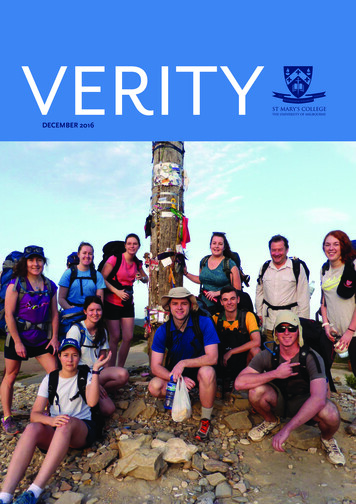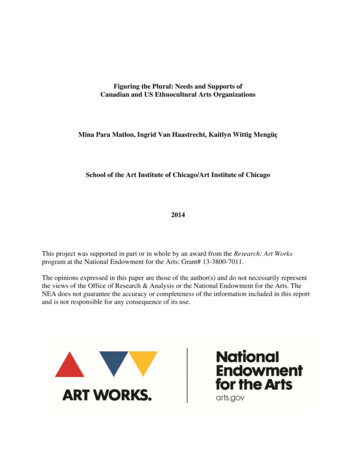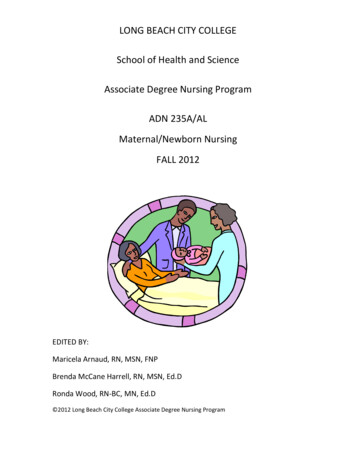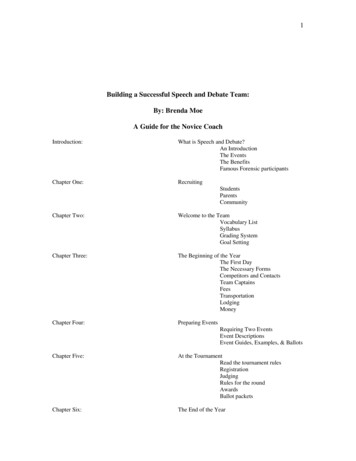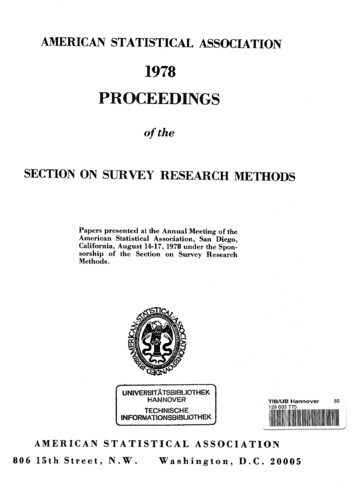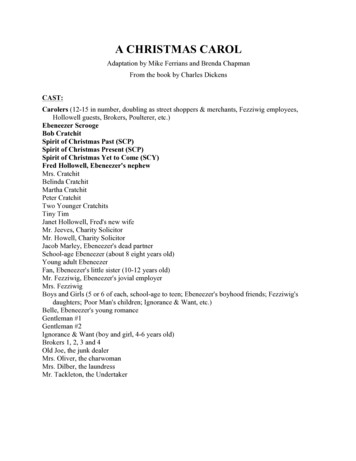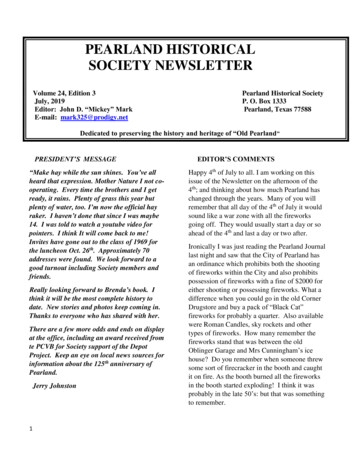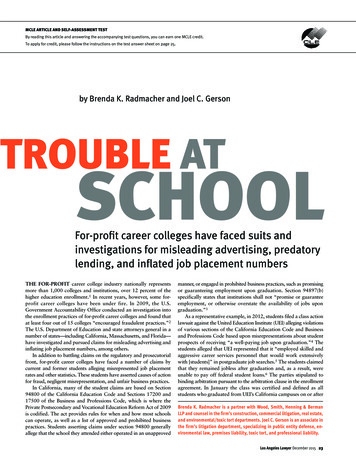
Transcription
MCLE ARTICLE AND SELF-ASSESSMENT TESTBy reading this article and answering the accompanying test questions, you can earn one MCLE credit.To apply for credit, please follow the instructions on the test answer sheet on page 25.by Brenda K. Radmacher and Joel C. GersonTROUBLE ATSCHOOLFor-profit career colleges have faced suits andinvestigations for misleading advertising, predatorylending, and inflated job placement numbersTHE FOR-PROFIT career college industry nationally representsmore than 1,000 colleges and institutions, over 12 percent of thehigher education enrollment.1 In recent years, however, some forprofit career colleges have been under fire. In 2009, the U.S.Government Accountability Office conducted an investigation intothe enrollment practices of for-profit career colleges and found thatat least four out of 15 colleges “encouraged fraudulent practices.”2The U.S. Department of Education and state attorneys general in anumber of states—including California, Massachusetts, and Florida—have investigated and pursued claims for misleading advertising andinflating job placement numbers, among others.In addition to battling claims on the regulatory and prosecutorialfront, for-profit career colleges have faced a number of claims bycurrent and former students alleging misrepresented job placementrates and other statistics. These students have asserted causes of actionfor fraud, negligent misrepresentation, and unfair business practices.In California, many of the student claims are based on Section94800 of the California Education Code and Sections 17200 and17500 of the Business and Professions Code, which is where thePrivate Postsecondary and Vocational Education Reform Act of 2009is codified. The act provides rules for when and how most schoolscan operate, as well as a list of approved and prohibited businesspractices. Students asserting claims under section 94800 generallyallege that the school they attended either operated in an unapprovedmanner, or engaged in prohibited business practices, such as promisingor guaranteeing employment upon graduation. Section 94897(b)specifically states that institutions shall not “promise or guaranteeemployment, or otherwise overstate the availability of jobs upongraduation.”3As a representative example, in 2012, students filed a class actionlawsuit against the United Education Institute (UEI) alleging violationsof various sections of the California Education Code and Businessand Professions Code based upon misrepresentations about studentprospects of receiving “a well-paying job upon graduation.”4 Thestudents alleged that UEI represented that it “employed skilled andaggressive career services personnel that would work extensivelywith [students]” in postgraduate job searches.5 The students claimedthat they remained jobless after graduation and, as a result, wereunable to pay off federal student loans.6 The parties stipulated tobinding arbitration pursuant to the arbitration clause in the enrollmentagreement. In January the class was certified and defined as allstudents who graduated from UEI’s California campuses on or afterBrenda K. Radmacher is a partner with Wood, Smith, Henning & BermanLLP and counsel in the firm’s construction, commercial litigation, real estate,and environmental/toxic tort departments. Joel C. Gerson is an associate inthe firm’s litigation department, specializing in public entity defense, environmental law, premises liability, toxic tort, and professional liability.Los Angeles Lawyer December 2015 23
October 15, 2008, and enrolled before August22, 2013, and, within six months of graduation, did not find employment working atleast 32 hours per week in a single positionwithin their field of study.7In addition to claims under the EducationCode, students frequently allege claims underBusiness and Professions Code Sections 17200and 17500. Section 17200 prohibits unfaircompetition by prohibiting any “unlawful,unfair or fraudulent business act or practice”and any “unfair, deceptive, untrue or misleading advertising.”8 Section 17500 specifically prohibits untrue or misleading advertisingthat is known, or which reasonably shouldbe known, to be untrue or misleading.9In 2004, for example, a student filed aclass action lawsuit against Microskills SanDiego L.P. (Microskills), accusing the postsecondary vocational school of using outdatedstatistical information to induce potentialstudents into believing that the high-techindustry was booming with high-paying jobsavailable to its graduates.10 The complaintalleged that Microskills did not provide accurate information of postgraduate employmentrates, thereby misleading students.11 Microskills moved to compel arbitration, whichwas denied, and lost on appeal.12 In 2006,Microskills closed its doors, leaving over 100students with no option to complete theirdegrees. In 2007, the California attorney general and the San Diego district attorney’soffice filed a complaint against Microskillsalleging unfair business practices pursuantto Sections 17200 and 17500.13 In 2008, thecompany settled and agreed to pay 300,000in restitution to 71 students.14In conjunction with these statutory claims,students have alleged common law claims offraud and negligent misrepresentation. Fraudgenerally occurs when someone gains something of value, usually money or property,by knowingly making a false representationof a material fact to another individual. Tosucceed on a fraud claim, a student mustprove: 1) the school made a representationto the student that was materially false, 2)the school knew that the representation wasfalse when made, or that it made the representation recklessly and without regard forits truth or falsity, 3) the school intended todefraud the student or to induce the student’sreliance, 4) the student reasonably relied onthe representation, and 5) the student washarmed.15 Students that have alleged fraudagainst a for-profit college or vocationalschool typically claim that a college counselormisrepresented future job prospects to thembefore they started at the school.Negligent misrepresentation occurs whena party asserts a fact that is not true and forwhich it has no reasonable ground for believing to be true. Students asserting negligent24 Los Angeles Lawyer December 2015misrepresentation tend to claim that theschool made misrepresentations to themthrough a school’s advertisements, website,or recruiters. To prove negligent misrepresentation students must show that 1) theschool misrepresented a fact, 2) the schoolhad no reasonable ground for believing thefact to be true, 3) the school intended toinduce the students’ reliance on the misrepresented fact, 4) the students reasonably reliedon the misrepresentation, and 5) the studentswere harmed.16 The main difference betweena fraud and negligent misrepresentation claimis that negligent misrepresentation does notrequire an element of scienter or intent.In Goehring v. Chapman University, threeChapman University law students from theschool’s inaugural class alleged both fraudand negligent misrepresentation claims againsttheir former school. The students claimedthat Chapman University Law School didnot fully disclose its ABA accreditationprocess and falsely represented that studentswould be eligible to sit for the California barexam without accreditation.17 However, thestudents failed to satisfy the damages elementsfor their causes of action because they wereunable to prove that their damages weredirectly related to their reliance on the representations made by Chapman University.18While fraud and misrepresentation claimshave been difficult to establish against forprofit career colleges, claims under otherstatutes have been successful. In Spielman v.Ex’pression Center for New Media, for example, students sued their former school underthe now-repealed Private Postsecondary andVocational Education Reform Act of 1989.19The act prohibited private postsecondary educational institutions from misrepresentingtheir business in statements made to students.20Rather than reading all the elements of common law misrepresentation into the statute,the court allowed for a remand so that thestudents’ claims could be interpreted underthe plain meaning of the statute.21 The courtnoted that its own conclusion is “buttressedby the fact that there are similar statutes which have been found not to include theelements of common law fraud unless thoseelements are made express in law.”22Corinthian Colleges Case StudyBy understanding the statutory and commonlaw claims brought by students, for-profitcareer colleges can be better equipped to takepreventative measures to avoid these claims.Educators can also learn from the travailsof other institutions, such as Corinthian Colleges. Founded in 1995, Corinthian was aprofitable educational institution with morethan 100 college campuses. However, inOctober 2013, the California Attorney General filed a complaint against Corinthian andits subsidiaries for misrepresenting job placement rates to students and investors, falseadvertising, and unlawful enrollment provisions barring student claims.23 The complaintaccused Corinthian of marketing false advertisements to potential students that were “isolated,” “impatient,” individuals with “lowself-esteem,” and to students who have “fewpeople in their lives who care about them”and who are “stuck” and “unable to see andplan well for the future.”24 These allegationswere made to show the predatory tactics. Inaddition, Corinthian allegedly used militarysymbols to attract veterans. The claims in thecase were that Corinthian specifically targetedstudents who would be less likely to completethe program or who might be more easilyswayed to enter the program based on therepresentations of the job placement rates.In 2014, following this complaint, theConsumer Financial Protection Bureau suedCorinthian for predatory lending against itsstudents and illegal debt collection.25 Twoyears before that, Corinthian had drawn theattention of the U.S. Senate’s Health, Education, Labor, and Pension Committee, whichstudied the enrollment, retention rates, andprofits of for-profit universities.26 The committee’s study concluded “Corinthian chargessome of the highest tuition prices,” yet it was“unclear whether taxpayers or students [were]obtaining value from the 1.7 billion investmentthat taxpayers made in Corinthian in 2010.”27The U.S. Department of Education thereafter began financially monitoring Corinthian. Because of the department’s intervention, Corinthian was forced to sell a dozenof its campuses and to close 85 more.28 InApril, Corinthian closed the remainder of itscampuses, leaving 16,000 students displaced.Corinthian has since filed for chapter 11bankruptcy, which has effectively stayed litigation against the school.29 As a result, theDepartment of Education instituted a federalloan forgiveness program to help relieve thefinancial burden on the students affected bythe closing of Corinthian’s campuses.30Effectively Preventing Student ClaimsThe case of Corinthian Colleges is an extremeexample of what can happen to for-profitcareer colleges that mislead students withaggressive marketing and deceptive advertising. However, there are many more careercolleges and schools in the business of providing quality trade and technical skills tostudents who need them. Those schools canlearn from the Corinthian example and somesimple strategies to avoid claims by students.First, schools should strive to be openand honest with students about their chancesof graduating and finding a full-time job. Itis imperative to establish transparency withstudents at the outset in order to establish
MCLE Test No. 252The Los Angeles County Bar Association certifies that this activity has been approved for MinimumContinuing Legal Education credit by the State Bar of California in the amount of 1 hour.MCLE Answer Sheet #252TROUBLE AT SCHOOLNameLaw Firm/Organization1. The U.S. Government Accountability Office will notinterfere with the practices of for-profit career colleges.True.False.2. Students commonly bring claims against schoolsunder the Business and Professions Code.True.False.3. The California Education Code provides guidelinesfor how schools can operate.True.False.4. A school cannot be disciplined for overstating theavailability of jobs upon graduation.True.False.5. A school can freely advertise truthful informationabout graduation rates and prospects for employment.True.False.6. Student claims against a school for unfair businesspractices can lead to a school’s closing.True.False.12. The main difference between fraud and negligentmisrepresentation is that fraud requires an elementof scienter.True.False.13. A student is able to sue a former school even if heor she is not a current student at that school.True.False.14. The Consumer Financial Protection Bureau mayprotect the interests of students against predatorylending and illegal debt collection.True.False.15. The U.S. Senate’s Health, Education, Labor, andPension Committee studies the enrollment, retentionrates, and profits of for-profit universities.True.False.16. California state-funded schools are not requiredto comply with California’s record management program.True.False.7. Schools are permitted to advertise information thatthey reasonably could know may be misleading.True.False.17. Schools should make statistics easily available toprospective students regarding tuition costs, graduationrates, and hiring opportunities.True.False.8. A student can bring both statutory and commonlaw claims against a school.True.False.18. Schools should only maintain records for one yearin case a claim is later brought against them.True.False.9. In order to succeed on a claim for fraud, a studentdoes not need to prove that the school knew that therepresentation it was making was false.True.False.19. In Goehring v. Chapman University, the studentclaimants were able to succeed on their causes ofaction despite their inability to prove that their damageswere directly related to their reliance on representationsmade by the school.True.False.10. In order to succeed on a claim of negligent misrepresentation, a student does not need to prove thatthe school intended to induce the student’s reliance.True.False.11. In order to succeed on a claim of negligent misrepresentation, a student does not need to prove thathe or she was harmed.True.False.20. Both the California Code of Regulations and theCode of Federal Regulations govern record neState Bar #INSTRUCTIONS FOR OBTAINING MCLE CREDITS1. Study the MCLE article in this issue.2. Answer the test questions opposite by markingthe appropriate boxes below. Each questionhas only one answer. Photocopies of thisanswer sheet may be submitted; however, thisform should not be enlarged or reduced.3. Mail the answer sheet and the 20 testing fee( 25 for non-LACBA members) to:Los Angeles LawyerMCLE TestP.O. Box 55020Los Angeles, CA 90055Make checks payable to Los Angeles Lawyer.4. Within six weeks, Los Angeles Lawyer willreturn your test with the correct answers, arationale for the correct answers, and acertificate verifying the MCLE credit you earnedthrough this self-assessment activity.5. For future reference, please retain the MCLEtest materials returned to you.ANSWERSMark your answers to the test by checking theappropriate boxes below. Each question has onlyone 8.19.20.n Truen Falsen Truen Falsen Truen Truen Truen Truen Truen Truen Truen Truen Truen Truen Truen Truen Truen Truen Truen Truen Truen Truen Falsen Falsen Falsen Falsen Falsen Falsen Falsen Falsen Falsen Falsen Falsen Falsen Falsen Falsen Falsen Falsen Falsen FalseLos Angeles Lawyer December 2015 25
trust and to avoid unnecessary student claims.This can most simply be done by makingstatistics regarding student costs, graduationrates, and hiring opportunities easily availableon the school website, in advertising materials,and elsewhere.Second, schools should maintain a strongtraining program that instructs counselorsand marketers on what they can and cannotsay. Since many of the claims involve a counselor’s guaranteeing job placement or particular job outcomes, schools must stress tocounselors the importance of avoiding overblown promises. Schools should retain documentation of the training process.Third, schools should have students signan acknowledgement before enrolling thatthey understand their counselor is not guaranteeing them a job. The acknowledgementshould include language that shows the student was not relying on any other form ofadvertisement when enrolling. This will helppreclude claims under the California Education Code as well as allegations of negligentmisrepresentation.Fourth, schools should also regularly referto state and federal enforcement agenciessuch as the Bureau for Private PostsecondaryEducation for important updates and proposed regulations to ensure compliance. TheU.S. Department of Education has also estab-26 Los Angeles Lawyer December 2015lished a Negotiated Rulemaking Committeeon Gainful Employment to prepare proposedregulations that establish standards for programs that prepare students for gainful employment in a recognized occupation.31Finally, one of the most important stepsin preventing student claims is to maintaincomplete records. Having hard documentation of the practices and procedures of theschool will go leagues in helping prove thatthe school abided by state and federal laws.Schools should have an organized documentretention policy, including electronic documents, so that these documents may be preserved for electronic discovery if litigationappears imminent. Schools should maintainrecords for at least four years, since this isthe point at which claims of fraud and breachof contract expire. If a student has not fileda lawsuit within three years of the date of thealleged fraud (or four years in the case of abreach-of-contract claim), then he or she isbarred from bringing that claim. Schools shouldalso stay current on statutory record retention requirements. California state-fundedschools are required to comply with California’s record management program in orderto “apply efficient and economical management methods to the creation, utilization,maintenance, retention, preservation and disposal of state records.”32 The California Edu-cation Code and Code of Regulations, as wellas Code of Federal Regulations, include sections governing record retention.33The rising trend of student and agencyclaims against for-profit career colleges posesa risk of which schools should be wary. Byunderstanding the current climate surrounding for-profit career colleges, common claims,and engaging in appropriate preventativemeasures, schools can place themselves in astrong position to effectively manage the riskthat student claims present.n1THE CONDITION OF EDUCATION, NAT’L CTR. FOREDUC. STATISTICS (May 2015) available at http://nces.ed.gov.2 FOR-PROFIT COLLEGES: UNDERCOVER TESTING FINDSC OLLEGES E NCOURAGED F RAUD AND E NGAGED INDECEPTIVE AND QUESTIONABLE MARKETING PRACTICE,U.S. GOVERNMENT ACCOUNTABILITY OFFICE (Aug. 4,2010), available at http://www.gao.gov.3 EDUC. CODE §94897.4 Cordova, et al. v. United Educ. Inst., No. 37-201200083573-CU-BT-CTL, 2012 WL 5193823 passim(San Diego Super. Ct. Oct. 15, 2012) (Cross-ActionComplaint for Damages, Injunctive Relief, andRestitution).5 Id.6 Id.7 Cordova, et al. v. United Educ. Inst., No. 37-201200083573-CU-BT-CTL, 2012 WL 5193823 passim(San Diego Super. Ct. Feb. 1, 2013) (Siptulation forBinding Arbitration and Stay of Action and [Proposed]Order Thereon).
8CAL. CODE REGS. tit. 6, §17200. This section expandsthe reach of government agencies monitor the advertising claims by colleges and vocational schools byproviding that a government agency can seek recoveryon behalf of the students for false advertising. See alsoCAL. CODE REGS. tit. 6, §76212.9 The Education Code als
Oct 21, 2015 · of other institutions, such as Corinthian Col-leges. Founded in 1995, Corinthian was a profitable educational institution with more than 100 college campuses. However, in October 2013, the California Attorney Gen- eral filed a complaint against Corinthian and its subsidiaries for misrepresent
